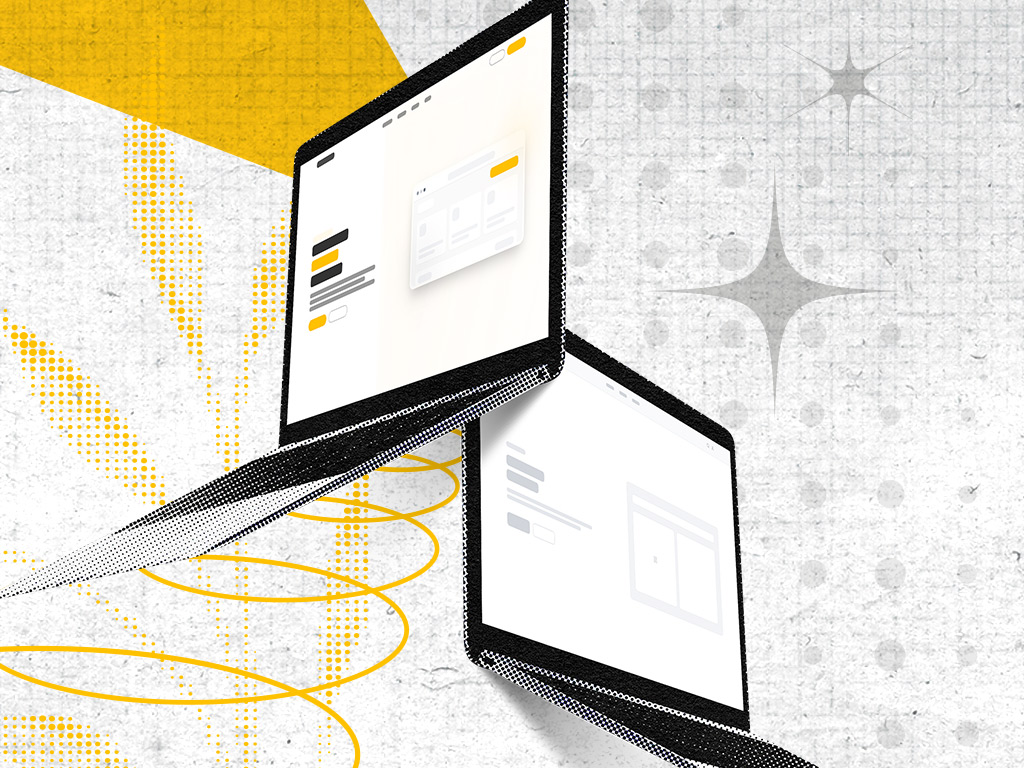Imagine stepping into your favorite coffee shop. The atmosphere is warm and inviting, each cozy corner is perfect for conversing with a friend or jamming on your laptop, the interior decor is perfectly Instagramable, and everything seems tailor-made for your comfort and convenience.
This perfect blend of aesthetics and functionality doesn’t happen by accident; it results from meticulous design and thoughtful execution, much like the UI (user interface) and UX (user experience) in digital products. So, sit back, grab a cup of your favorite coffee (I’m really enjoying lavender lattes right now), and let’s look into these crucial elements that make or break the digital experiences and user journeys we encounter daily.
What’s the difference between UI and UX?
Let’s go back to your favorite coffee shop. The ambiance immediately puts you at ease; the lighting is perfect, the furniture inviting, and the menu is a visual treat. This delightful presentation represents excellent UI (user interface). Now, consider how the staff greets you warmly, how quickly you’re served, and how effortlessly you settle into your favorite spot; these details embody outstanding UX (user experience).
In digital product design, UI and UX work together in much the same way, each contributing uniquely to an exceptional digital experience. UI refers to the visual, graphic, and interactive elements of a digital product, focusing on aesthetics like typography, colors, and button styles. It captures attention and guides user interactions through intuitive visual design; much like a thoughtfully designed menu that’s both attractive and easy to read.
UX, on the other hand, is about the overall feel and ease of the experience. It ensures that navigating through a digital product is straightforward, efficient, and enjoyable, helping users achieve their goals with minimal friction. Just as a thoughtfully arranged coffee shop layout creates a seamless experience from ordering to sipping your latte, UX design creates smooth user journeys from first click to final action.
When UI and UX align perfectly, users enjoy digital products that are not only visually appealing but genuinely enjoyable and easy to use.
Learn more about Tallwave’s digital experience design services.
Creating a cohesive experience: How UI and UX overlap and interact
In the digital product landscape, UI and UX are two halves of a whole, each complementing and enhancing the other to create a cohesive user experience. While UI addresses the specifics of a product’s visual and interactive elements, UX focuses on the overall feel and flow of a user’s journey. Their effective integration is crucial for ensuring that a digital product is not only aesthetically pleasing but also functionally seamless.
Here are a handful of ways UX and UI work together:
- Visual and functional harmony: Consider a mobile app that is visually stunning with high-definition images and a sophisticated color scheme (UI), paired with a user-friendly interface that allows easy navigation and minimal load times (UX). Here, the visual appeal attracts users and the seamless functionality keeps them engaged, demonstrating the harmonious interaction between UI and UX.
- Feedback loops: In a well-integrated UI/UX design, feedback loops help maintain communication with the user. For instance, a “buy now” button that changes color when clicked (UI) combined with immediate purchase confirmation when clicked (UX) reassures the user that their command has been processed. This blend of visual confirmation and functional feedback is essential for a satisfying user experience.
- Consistency across all elements: Consistency in design elements like fonts, colors, and layout (UI) combined with consistent performance across different sections of an app or website (UX) create a unified experience that enhances user trust and satisfaction. Users feel more comfortable and confident navigating a product that behaves predictively across all interactions.
- Adaptive design: Consider a responsive website that adjusts its layout (UI) for different devices, ensuring that no matter the screen size, the content is easy to read and interact with (UX). This adaptability improves the user experience by making the product accessible and enjoyable on any device, thereby extending the product’s reach and increasing user engagement.
- Error handling: How errors are handled is another area where UI and UX intersect. An error message that is clearly visible and designed in a way that matches the aesthetic of the rest of the application (UI), which also provides a helpful, easy-to-understand solution or directs users back on track (UX), turns potential frustration into a positive interaction.
Better together: Why the integration of UX and UI matters
The overlap of UI and UX isn’t just about making things pretty or boosting functionality; it’s about crafting digital experiences that resonate with users at every touchpoint. A product developed with an integrated approach ensures users’ needs are met seamlessly, from first interaction to lasting engagement, delivering experiences that are memorable, satisfying, and genuinely impactful.
To achieve this kind of harmony, design teams rely on strategic methods like wireframing, prototyping, and usability testing. Wireframes set the foundational blueprint for aligning structure and user goals; prototypes bring interactive concepts to life, allowing teams to fine-tune how users will interact with each element; and usability testing validates that both UI and UX are working together effectively to meet user expectations.
When you combine these methods thoughtfully, you don’t just create products that look good—you create cohesive, delightful experiences that keep users coming back and set your product apart in a crowded marketplace.
Creating emotional connections with UI and UX
Both UI and UX profoundly influence user psychology. A well-crafted UI can evoke a range of positive emotions, making users feel calm, happy, or excited. The strategic choice of colors and shapes plays a critical role in influencing user mood and perception. For example, certain colors can enhance usability and make interfaces feel more inviting and user-friendly. Warm colors like orange and yellow create a sense of excitement, while cooler colors like green and blue evoke calmness and relaxation.
UI/UX and cognitive psychology
UX design utilizes principles of cognitive psychology to optimize user satisfaction by making interactions feel effortless and rewarding. A key aspect is managing cognitive load; designs should aim to minimize the mental effort required by users. This makes it easier for them to complete tasks efficiently and with greater satisfaction. Effective UX organizes information hierarchically and utilizes familiar UI patterns, which helps reduce the time users spend learning how to navigate and decreases decision fatigue.
Behavioral psychology in UI/UX
UI/UX design also taps into behavioral psychology to influence user actions and decisions. Employing psychological triggers such as limited-time offers or visual progress bars motivates users to complete tasks. These strategies leverage the human desire to achieve goals, significantly enhancing user engagement and promoting retention.
Incorporating accessibility into psychological considerations
When integrating accessibility into UI and UX design, it’s crucial to address the psychological comfort of all users, including those with disabilities. Accessible design extends beyond physical usability to include the cognitive aspects of the user experience. Ensuring adequate color contrast for readability, enabling seamless keyboard navigation, and providing compatibility with assistive technologies like screen readers and voice navigation tools are key considerations. Content and navigation must be perceivable, understandable, and predictable to ensure that all users can interact with the product effectively, supporting a universally positive user experience.
See how Tallwave uses accessible app design to create experiences that are friendly for all users.
Putting it in action: Signs it’s time to improve UI and UX
By addressing common UI and UX issues, businesses can significantly improve their digital products’ effectiveness and user satisfaction. Metrics and user feedback play essential roles in identifying these issues, guiding the design process to focus on creating solutions that are not only visually appealing but also deeply satisfying to interact with. This approach ensures that digital experiences are accessible, enjoyable, and successful, aligning with user expectations and business goals.
Recognizing the need for better UI design
- Inconsistent branding across platforms: If your branding is different on mobile compared to desktop or across different pages of your site, your UI lacks consistency.
- Low user engagement: Metrics like short page visits and low interaction with call-to-action buttons can indicate that the UI isn’t engaging or intuitive enough.
- Poor accessibility scores: If accessibility tools report poor scores, your UI may not be accessible to all users, including those with disabilities.
- Negative user feedback: Direct user feedback or usability testing results that point to confusion or difficulty in using the interface clearly signal a need for UI improvements.
Indicators that your UX needs enhancement
- High user drop-off rates: If analytics show that users frequently abandon tasks midway, such as filling out forms or completing purchases, the UX likely needs to be more intuitive.
- Low conversion rates: Despite good traffic, if few visitors are converting (e.g., signing up, purchasing, or downloading), the UX may not be effectively guiding them to these actions.
- Negative user feedback: Regular comments about the site or app being hard to navigate, frustrating, or difficult to understand suggest UX deficiencies.
- Repeated tasks are difficult: If users struggle to perform actions they frequently need to complete, like resetting passwords or updating profiles, it indicates a UX problem.
- Low task success rate: If usability tests show that many users cannot successfully complete basic tasks, it’s a clear sign that the UX design needs to be revisited.
Wrapping up: UI and UX are both crucial in digital design
As we’ve explored, UI and UX play crucial roles in creating digital products that are not only functional but also delightful to use. They are like the coffee and the cup; one delivers the core experience, and the other enhances it. And at Tallwave, we excel in weaving these elements together to create superior digital experiences that engage and satisfy on all levels.
Next time you interact with an app or website, pause for a moment and reflect: Is the experience seamless and engaging, or does something feel off? That’s the power of UI and UX at play.












